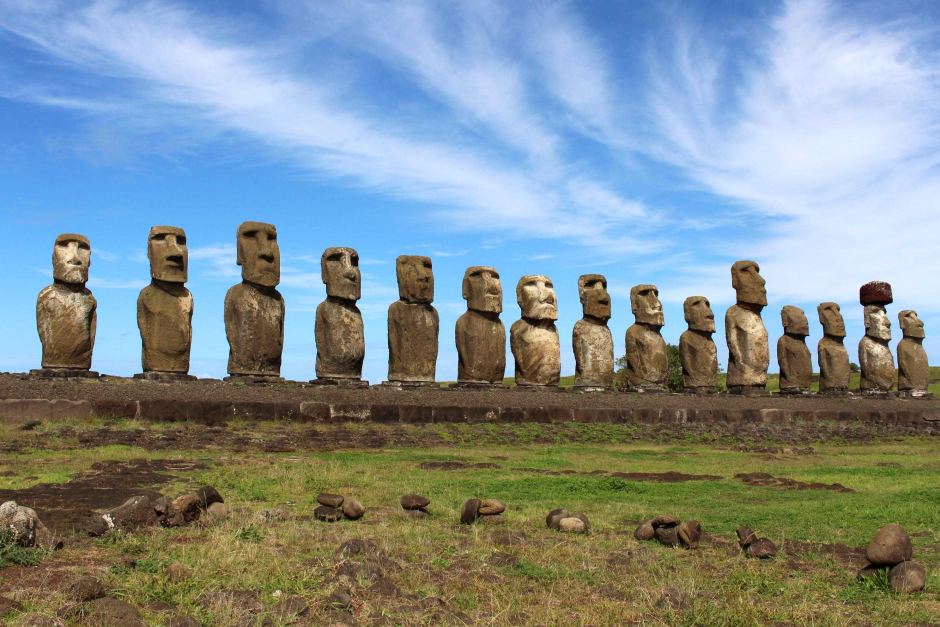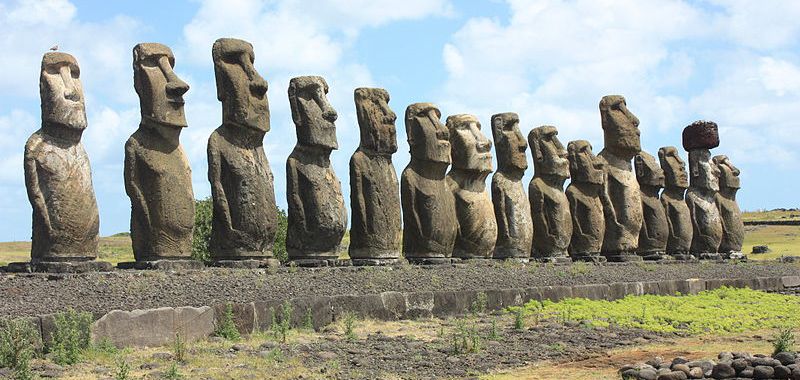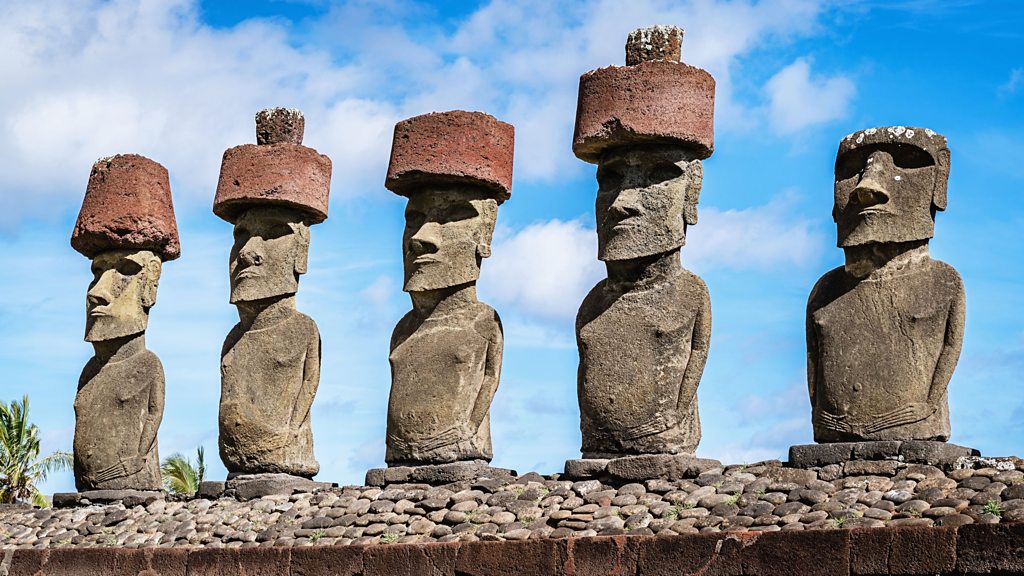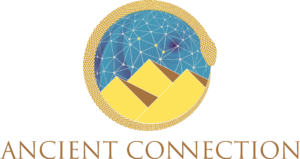Easter Island's Megalithic Statues

Easter Island, or Rapa Nui in the original language, is an island of Chile in the southeastern Pacific Ocean. Easter Island’s megalithic statues made this remote island globally famous.
There are in fact nearly 1,000 megalithic monumental statues, called Moai and allegedly created by the early Rapa Nui people.
In 1995, UNESCO named Easter Island a World Heritage Site, with much of the island protected within Rapa Nui National Park.

The Moai of Easter Island: Ancient Mysteries Carved in Stone
The Moai statues of Easter Island (Rapa Nui) stand as some of the most iconic and enigmatic monuments in the world. These colossal stone figures, weighing up to 82 tons and reaching heights of 33 feet, are scattered across the island, silently gazing inland. For centuries, their origins, purpose, and the methods of their construction and positioning have puzzled researchers and fueled debates. While mainstream archaeology offers theories about their creation and transportation, these explanations often fall short, leaving room for the possibility that the Moai—and other megalithic structures on the island—may be far older and more mysterious than currently acknowledged.
Flaws in Mainstream Theories
Modern archaeological theories propose that the Rapa Nui people carved the Moai from volcanic tuff using stone tools and transported them using sledges, ropes, or rolling logs. While these ideas are intriguing, they fail to address critical questions. For example, how could an isolated society with limited resources and no metal tools have carved, moved, and erected such enormous statues with precision? And why would they undertake such an enormous project on an island with a fragile ecosystem, risking deforestation and societal collapse?
Attempts to recreate the Moai’s transportation methods have resulted in mixed success, often requiring ideal conditions and extensive resources that do not align with the limitations of ancient Rapa Nui. The lack of definitive evidence for these methods has led many to believe that current theories are speculative at best and fail to capture the true sophistication of the Moai builders.
Could the Moai Be Much Older?

While the mainstream narrative dates the Moai to between 1100 and 1600 CE, some researchers argue that these statues could be much older. Geological evidence suggests that erosion patterns on the Moai might point to an earlier timeline, potentially aligning with other ancient megalithic structures worldwide. This perspective raises intriguing questions: were the Moai part of an older, advanced civilization that predated the Polynesian settlement of Easter Island?
Legends from the island itself speak of a time when a more advanced culture, often described as the “Long-Ears” or Hanau Eepe, may have been responsible for the statues. Could these myths hint at a lost chapter of human history, erased by time and subsequent colonization of the island?
The Mysterious Megalithic Wall
Easter Island is not only home to the Moai but also to a remarkable stone wall near the ceremonial site of Vinapu. This wall, composed of meticulously fitted stone blocks, bears an uncanny resemblance to the megalithic construction techniques found in South America, such as those in Cuzco and Machu Picchu, as well as in Egypt’s Valley Temple and the Osireion at Abydos.
The precision of the stonework is striking. The blocks are cut and fitted so perfectly that they require no mortar, and the structures exhibit anti-seismic properties—a feat of engineering that even modern builders struggle to replicate. These similarities suggest a shared knowledge or cultural connection between the builders of Easter Island and other ancient megalithic sites, challenging the isolated nature of the island and pointing to the possibility of a global network of advanced civilizations in prehistory.
The wall is located at the archaeological site called Ahu Vinapu and might be just the foundation of what was a much larger structure.
The Anti-Seismic Clue
The anti-seismic properties of these walls provide a compelling clue about the builders’ expertise. By creating interlocking stone blocks, these ancient architects ensured that the structures could withstand earthquakes, which are common in seismically active regions. This technique, seen across continents, reveals a level of engineering sophistication that contradicts the notion of primitive societies working in isolation. Could the builders of Easter Island have been part of a broader, interconnected civilization that shared advanced knowledge of architecture, geology, and engineering?
The Bodies of the Moai
Recently, excavations unearthed the bodies of some of the giant heads, to reveal petroglyphs etched on the torso and back of the statues. Prior to the excavations, it was commonly believed that the Moai didn’t have a body. As of today, the petroglyphs have not been deciphered.
Some of the Moai also wear a headdress called “pukao” by the Rapa Nui people.
Other than several ongoing debates and theories on how the moai could’ve been transported on-site, there are also hypotheses and speculations on how the Rapa Nui people could’ve placed the megalithic headdresses upon the statues.

The Rongorongo Language
Easter Island is the only one in the South Pacific area to have developed its own writing system, called Rongorongo.
However, there has been no lack of controversy in the scientific world, even with regard to indigenous writing; American archaeologist Kenneth P. Emory argued that the few written tablets discovered between 1722 and 1868 were nothing more than indigenous peoples’ imitations of the writing used by the early discoverers of Easter Island. However, no similar written language could be compared to the Rongorongo.
The Rongorongo writing system has not been fully deciphered and has remained misunderstood for many decades. Thanks to the studies conducted by the German Thomas Barthel and to the discovery of a tablet that reported a lunar calendar (now preserved in the archive of the SS Hearts in Grottaferrata near Rome), the so-called Mamari tablet, it was possible to partially decipher some symbols.
Worldwide there are 26 tablets written in Rongorongo, of which only a small part has been translated.
A Legacy Shrouded in Mystery
The Moai and the megalithic wall of Easter Island defy easy explanation. Mainstream theories about their construction and purpose often rely on assumptions that dismiss the possibility of a more advanced ancient civilization. Yet the precision of the stonework, the similarities to other megalithic sites, and the unresolved questions about their age and purpose suggest that the true story of Easter Island is far more complex.
As research continues and new evidence emerges, the Moai may one day reveal their secrets. Until then, they remain a testament to the ingenuity and mystery of ancient humanity, inviting us to reconsider what we think we know about our past. Perhaps the answers lie not in isolation, but in a forgotten chapter of a global civilization, one whose knowledge and achievements continue to echo across the millennia.
